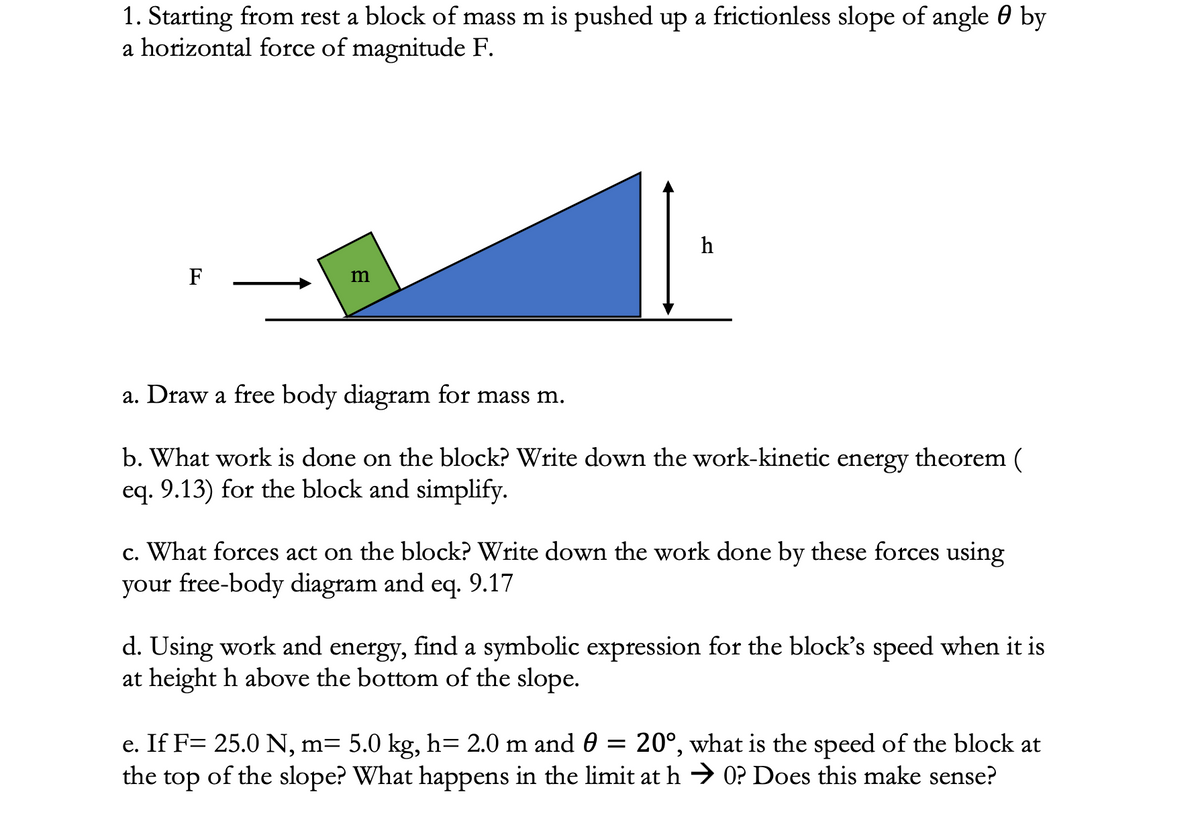1. Starting from rest a block of mass m is pushed up a frictionless slope of angle 0 by a horizontal force of magnitude F. h F m a. Draw a free body diagram for mass m. b. What work is done on the block? Write down the work-kinetic energy theorem ( eq. 9.13) for the block and simplify. c. What forces act on the block? Write down the work done by these forces using your free-body diagram and eq. 9.17
1. Starting from rest a block of mass m is pushed up a frictionless slope of angle 0 by a horizontal force of magnitude F. h F m a. Draw a free body diagram for mass m. b. What work is done on the block? Write down the work-kinetic energy theorem ( eq. 9.13) for the block and simplify. c. What forces act on the block? Write down the work done by these forces using your free-body diagram and eq. 9.17
College Physics
10th Edition
ISBN:9781285737027
Author:Raymond A. Serway, Chris Vuille
Publisher:Raymond A. Serway, Chris Vuille
Chapter5: Energy
Section: Chapter Questions
Problem 40P: (a) A block with a mass m is pulled along a horizontal surface for a distance x by a constant force...
Related questions
Question
Solve a,b and c

Transcribed Image Text:1. Starting from rest a block of mass m is pushed up a frictionless slope of angle 0 by
a horizontal force of magnitude F.
h
F
m
a. Draw a free body diagram for mass m.
b. What work is done on the block? Write down the work-kinetic energy theorem (
eq. 9.13) for the block and simplify.
c. What forces act on the block? Write down the work done by these forces using
your free-body diagram and eq. 9.17
eq.
d. Using work and energy, find a symbolic expression for the block's speed when it is
at height h above the bottom of the slope.
20°, what is the speed of the block at
e. If F= 25.0 N, m= 5.0 kg, h= 2.0 m and 0 =
the top of the slope? What happens in the limit at h → 0? Does this make sense?
Expert Solution
This question has been solved!
Explore an expertly crafted, step-by-step solution for a thorough understanding of key concepts.
This is a popular solution!
Trending now
This is a popular solution!
Step by step
Solved in 4 steps with 4 images

Knowledge Booster
Learn more about
Need a deep-dive on the concept behind this application? Look no further. Learn more about this topic, physics and related others by exploring similar questions and additional content below.Recommended textbooks for you

College Physics
Physics
ISBN:
9781285737027
Author:
Raymond A. Serway, Chris Vuille
Publisher:
Cengage Learning

College Physics
Physics
ISBN:
9781938168000
Author:
Paul Peter Urone, Roger Hinrichs
Publisher:
OpenStax College

University Physics Volume 1
Physics
ISBN:
9781938168277
Author:
William Moebs, Samuel J. Ling, Jeff Sanny
Publisher:
OpenStax - Rice University

College Physics
Physics
ISBN:
9781285737027
Author:
Raymond A. Serway, Chris Vuille
Publisher:
Cengage Learning

College Physics
Physics
ISBN:
9781938168000
Author:
Paul Peter Urone, Roger Hinrichs
Publisher:
OpenStax College

University Physics Volume 1
Physics
ISBN:
9781938168277
Author:
William Moebs, Samuel J. Ling, Jeff Sanny
Publisher:
OpenStax - Rice University

College Physics
Physics
ISBN:
9781305952300
Author:
Raymond A. Serway, Chris Vuille
Publisher:
Cengage Learning

Physics for Scientists and Engineers: Foundations…
Physics
ISBN:
9781133939146
Author:
Katz, Debora M.
Publisher:
Cengage Learning
